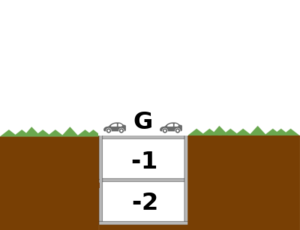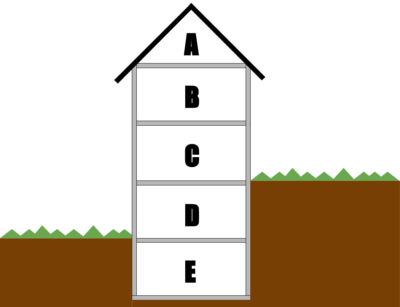Talk:Key:building:levels
Building start
The example is excellent, but I don't understand the section "Buildings that don't start at ground level". It seems to have been written by a non-native English speaker. Can someone clarify it? Jolter 22:37, 7 September 2012 (BST)
- I've added the same image as it is in the Simple 3D Buildings article, this should make it clearer. --Dakon (talk) 21:57, 16 February 2013 (UTC)
Cellar half underground
How would I tag a cellar that is half underground and half above ground? building:levels:underground=1 isn't really correct in this case. --Imagic (talk) 11:03, 19 March 2013 (UTC)
- Yes, I have almost the same question. How do we deal with a building on a steep hill such that a main entrance on one side enters one floor (or several floors!) higher than a main entrance on the other? Is building:levels counted from the lowest entrance or the highest one? Valavanisalex (talk) 08:46, 24 June 2013 (UTC)
- The lowest entrance. (Or more precisely, the lowest level which is above ground from any side, even if it doesn't have an entrance.) I'm surprised that this isn't mentioned here, actually. --Tordanik 21:57, 24 June 2013 (UTC)
- It seems this was never added before. I'll go ahead and add details about it, and a better picture. Oddityoverseer (talk) 15:19, 6 April 2016 (UTC)
- "The lowest entrance" seems clear enough. (Though it is not uncommon for houses (in Germany) to have direct entrances to their basement.) But how should we understand "the lowest level which is above ground"? Is this the case as soon as the ceiling is above ground level, or does it require the floor to be at ground level? -- DLichti (talk) 16:11, 27 November 2020 (UTC)

building:levels=1, building:levels:underground=1- Clearer definitions: Level 1 is . . .
- The lowest level whose floor is at or above grade level on at least one side
- The lowest storey that has, or could have, an entrance at or above grade, without any steps down
- The lowest storey that is completely exposed on at least one wall
- I think this page still needs improved explanation or another diagram, because I had to do a bunch of reading here to conclusively determine which is level=1 in the extremely common situation of a building with basement that has windows above grade. —Michael Z. 2025-07-14 23:11 z 23:11, 14 July 2025 (UTC)
- Clearer definitions: Level 1 is . . .
- I would love to see us arrive at a consensus on this and update the wiki page. Perhaps we could include that diagram if we go with that. I still to this day don't understand how to determine which is level=1. The wiki page says that partially underground levels should be included, but it cites an example lower on the page that isn't about the basement scenario (it's about the building on a slope scenario). --TronnaLegacy (talk) 00:37, 6 October 2025 (UTC)
Definition for bearing-out parts
I still believe that the definition for bearing-out parts is nonsense and contrary to how this is generally done. building:levels=* should be the amount of building levels, above ground and below ground, and not include non-existant building:levels like it is currently suggested. The building:min-level tag could remain, it would simply be the calculation logic that changes. --Dieterdreist (talk) 18:37, 13 January 2014 (UTC)
- I agree that non-existant levels shouldn't have to be included, it's counter-intuitive.
- If I understood correctly, you also argue that buildingːlevels should contain roofːlevels and buildingːlevelsːunderground. In this case I disagree, because buildingːlevels is most useful for 3D rendering the way it is right now, and it would be harder to collect the number of levels of many buildings otherwise.--Jgpacker (talk) 15:01, 19 March 2014 (UTC)
- A historic note for reference: There was once
building:levels:aboveground=*. There is currently still >2k instances of it. While I too disagree with this (the common meaning of levels of buildings should count above-ground main levels only), theoretically there could be a egbuilding:levels:total=*to show how many levels in total a building has. -- Kovposch (talk) 20:08, 29 February 2020 (UTC)
- A historic note for reference: There was once
This tag should be banned for points
Is there any reason to use it with points instead of ways? In 100% cases I see this tag used with points were mistakes when person selects not only way with building=yes but also points. Xxzme (talk) 04:03, 10 June 2014 (UTC)
- I agree with you that using this on nodes is likely an error. Some people like to mark the presence of a building with a node when they don't have an outline yet, so theoretically it could be correct in some rare cases. Then again, Key:building doesn't permit nodes either, so I'm ok with removing it. --Tordanik 18:11, 10 June 2014 (UTC)
- At the time of writing Key:building is allowed on nodes, and is a good idea to mark a building without the time, effort or access to imagery. Where you can tag a building as a node, then you should also be able to tag building:levels on that node. --Aharvey (talk) 01:24, 12 February 2021 (UTC)
How to mark levels that are partially under the roof
How should I mark levels that are partially under the roof? Example:
^ /A\ /---\ / \ | B | ------- | | | C | -------
Level B is halfway under the roof. How should I mark such case, building:levels=2 + roof:levels=1 or building:levels=1 + roof:levels=2 ?
- I would look to the windows. If the windows are in the roof so the level belong to the roof otherwise it belongs to the regular levels.
Access to specific levels
In the case of a multi-storey car-parks and mixed-use buildings, the ability to indicate that some levels are restricted may be useful. Is there a good way to signify that?
- If you're doing full indoor mapping (e.g. with Simple Indoor Tagging, you can probably use access tags on the relevant elements. I'm not aware of a solution that works purely with tags on the building itself. --Tordanik 15:18, 29 May 2018 (UTC)
What exactly is a level?
Consider a building with a pitched roof, like the one in the diagram above on this talk page. Suppose that A, immediately below the roof, doesn't contain any rooms, have floorboards, have windows, etc.; it's just an attic space. Is that a "level"? Is there by definition always a "level" there? I think the answer is that in that situation A is not a level; Key:level "indicates the floor level" and there's a diagram on the Simple Indoor Tagging page that shows a building with a basement, two actual floors, and unused space under a shallowly pitched roof with max_level=1. But it's not perfectly clear and I can imagine either answer being correct... Gareth McCaughan (talk) 20:40, 3 September 2018 (UTC)
- Came here to say that too as it was unclear when I was out surveying recently. I have concluded the same as you - attic spaces in the roof are not considered levels. A clearer definition in the article would be helpful. --Dónal (talk) 14:08, 20 August 2022 (UTC)
Skewed roof
I know quite some Dutch homes built in the 70s that have longer roofs. Some curious cases that leave me confused:
Longer roof on one side:
^ /A\ /---\ | \ | B \ --------\ | | | C | ---------
Longer roof with top level having even a wall on one side, and a small roof on the first floor:
|\ |A\ |--\ / \ | B \ --------\ | | | C | ---------
Longer roof on one side, attached shed (S) on the other (floorplan with roofline on the right):
^
/A\
/---\
| \
/| B \ --------------
/ --------\ | S | |
/ | | |___ | |
| S | C | | | |
------------- |____|____|
Can somebody shed a light on how to tag these examples?
- Using the common values for
roof:shape=*, I believe these cannot be modelled directly. But you could use more than one building part, each tagged withroof:shape=skillionand a suitableroof:direction=*. --Tordanik 16:35, 8 July 2020 (UTC)
Multi-storey carparks with the "roof" at ground level

How should a multi-storey car-park where the majority of the car-park is underground and the "roof" level is at ground level.
Is something like this correct:
amenity=parkingbuilding=parkingparking=multi-storeyoperator=*building:levels=0building:levels:underground=2
--Dónal (talk) 17:24, 2 November 2020 (UTC)
- Yes, that is correct. I would add also
location=undergroundMateusz Konieczny (talk) 06:04, 12 February 2021 (UTC)
levels between low and high ground
In the example  how do you tag there is one level between the low and high ground (level D), or how many levels from the high ground (levels B,C). --Aharvey (talk) 01:26, 12 February 2021 (UTC)
how do you tag there is one level between the low and high ground (level D), or how many levels from the high ground (levels B,C). --Aharvey (talk) 01:26, 12 February 2021 (UTC)
- I am not aware about such tagging existing. You may want to ask also on tagging mailing list or other contact channel, wiki pages often have quite low traffic Mateusz Konieczny (talk) 06:05, 12 February 2021 (UTC)
- You can approximate it at points such as entrances by adding level tags to them. A general solution doesn't exist yet. I've been thinking about proposing something like that because I need it for 3d rendering. But the way I would do it is to map "how high up [in levels or meters] is the ground at this node", because otherwise you still wouldn't know on what side of the building the higher ground is. --Tordanik 09:03, 12 February 2021 (UTC)
Where the roof:levels do start?
The tag description of Key:building:levels states, as does the original description for roof:levels=* (https://wiki.openstreetmap.org/wiki/Simple_3D_Buildings#Other_roof_tags), that roof:levels=* are the levels within the roof (A+B), but the example on the page counts the maximum number of levels over ground, with full room height for the entire level, as building:levels=* (even if they are in the roof), and levels without full room height as roof:levels. But it is difficult to determine if the levels have full height from outside the building, as a level within the roof may contain dead room to archive full room height. So roof:levels should always be the levels in the roof, even when the roof has roof:shape=gambrel, where most people would probably count the lower roof levels as building levels.
A similar problem exists for building:levels=* - are these the real levels above ground (and not within the roof), or the side with the maximum levels over ground (and not within the roof)? --Fabi2 (talk) 20:00, 6 August 2021 (UTC)
.5 of a level / split levels
I would assume that the reason someone would want to give a value of something.5 would be that it's a split level. The page doesn't say how to handle split levels, so I could see people thinking that a split level house with 4 floors would be 2.5 stories tall, and give that as the value. --Timefox 02:19, 4 April 2025 (UTC)